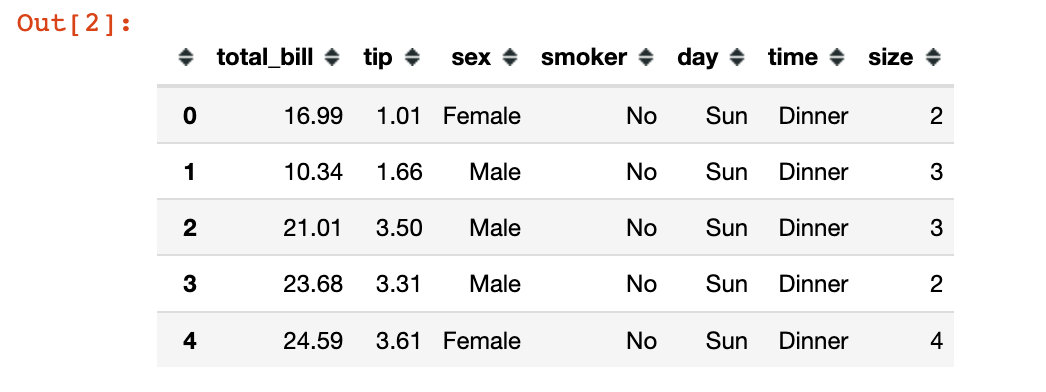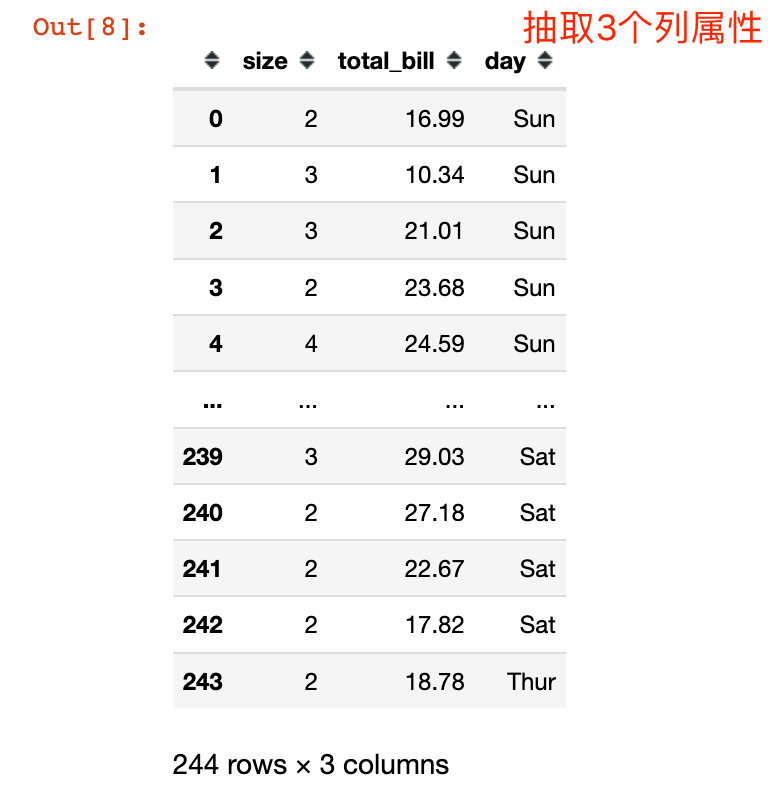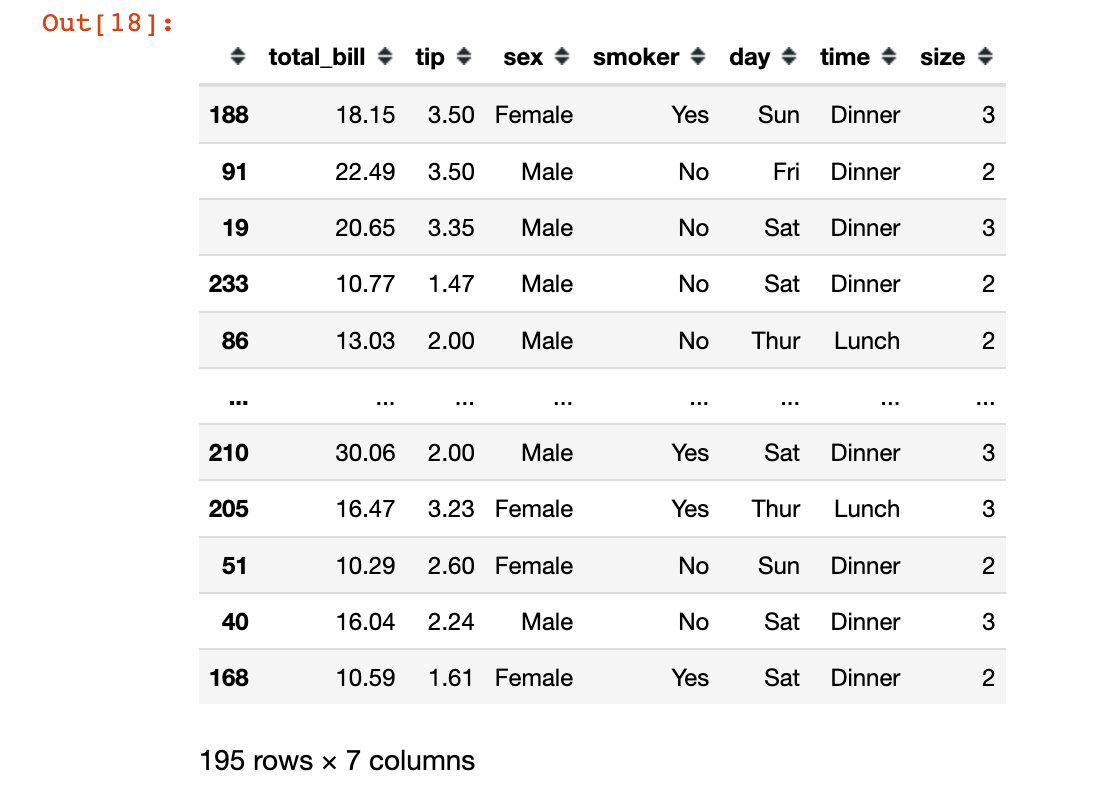Pandas+Numpy+Sklearn随机取数
Posted 尤尔小屋的猫
tags:
篇首语:本文由小常识网(cha138.com)小编为大家整理,主要介绍了Pandas+Numpy+Sklearn随机取数相关的知识,希望对你有一定的参考价值。
公众号:尤而小屋
作者:Peter
编辑:Peter
大家好,我是Peter~
本文记录的是如何使用Python、pandas、numpy、scikit-learn来实现随机打乱、抽取和切割数据。主要的方法包含:
- sample
- shuffle
- np.random.permutation
- train_test_split

导入数据
In [1]:
import pandas as pd
import numpy as np
import random # 随机模块
import plotly_express as px # 可视化库
import plotly.graph_objects as go
内置数据
采用的是plotly库中内置的一份消费数据集:
In [2]:
df = px.data.tips()
df.head()

基本信息
In [3]:
df.shape
Out[3]:
(244, 7)
In [4]:
columns = df.columns
columns
Out[4]:
Index(['total_bill', 'tip', 'sex', 'smoker', 'day', 'time', 'size'], dtype='object')
sample实现
行方向
In [5]:
随机抽取一行记录:
df.sample() # 随机抽取一行记录

随机抽取多行数据:

通过参数frac实现按照比例随机抽样:
df.sample(frac=0.05)

列方向
主要是选择不同数量或者比例的属性;整体的行数量是不变的
In [8]:
df.sample(3, axis=1) # 在列属性上抽取

shuffle实现
scikit-Learn的shuffle
In [9]:
from sklearn.utils import shuffle
In [10]:
shuffle(df) # 打乱数据

random模块的shuffle
In [11]:
length = list(range(len(df))) # 原始的长度作为索引
length[:5]
Out[11]:
[0, 1, 2, 3, 4]
In [12]:
random.shuffle(length) # 打乱索引
In [13]:
length[:5]
Out[13]:
[136, 35, 207, 127, 29] # 打乱后的结果
In [14]:
df.iloc[length] # 通过打乱后的索引获取数据

numpy实现
In [15]:
# 先打乱每个索引
np.random.permutation(len(df))
Out[15]:
array([223, 98, 238, 17, 101, 26, 122, 212, 27, 79, 210, 147, 176,
82, 164, 142, 141, 219, 6, 63, 185, 112, 158, 188, 242, 207,
45, 55, 178, 150, 217, 32, 16, 160, 157, 234, 95, 174, 93,
52, 57, 220, 216, 230, 35, 86, 125, 114, 100, 73, 83, 88,
34, 7, 40, 115, 97, 165, 84, 18, 197, 151, 135, 121, 72,
173, 228, 143, 227, 9, 183, 56, 23, 237, 136, 106, 133, 189,
139, 0, 208, 74, 166, 4, 68, 12, 71, 85, 172, 138, 149,
144, 232, 186, 99, 130, 41, 201, 204, 10, 167, 195, 66, 159,
213, 87, 103, 117, 31, 211, 190, 24, 243, 127, 48, 218, 233,
113, 81, 235, 229, 206, 96, 46, 222, 50, 156, 180, 214, 124,
240, 140, 89, 225, 2, 120, 58, 169, 193, 39, 102, 104, 148,
184, 170, 152, 153, 146, 179, 137, 129, 64, 3, 65, 128, 90,
110, 14, 226, 181, 131, 203, 221, 80, 51, 94, 231, 44, 108,
43, 145, 47, 75, 162, 163, 69, 126, 200, 1, 123, 37, 205,
111, 25, 91, 11, 42, 67, 118, 196, 161, 28, 116, 105, 33,
38, 78, 76, 224, 20, 202, 171, 177, 107, 8, 209, 239, 77,
241, 154, 5, 198, 92, 61, 182, 36, 70, 22, 54, 187, 175,
119, 215, 49, 134, 21, 60, 62, 168, 59, 155, 194, 109, 132,
19, 199, 29, 191, 13, 30, 192, 236, 15, 53])
In [16]:
# 通过打乱后的索引来选择数据
df.iloc[np.random.permutation(len(df))]

train_test_split实现
from sklearn.model_selection import train_test_split
data = []
for i in train_test_split(df, test_size=0.2):
data.append(i)
In [18]:
第一份数据是80%的:
data[0] # 80%的数据

剩余的20%的数据:

以上是关于Pandas+Numpy+Sklearn随机取数的主要内容,如果未能解决你的问题,请参考以下文章